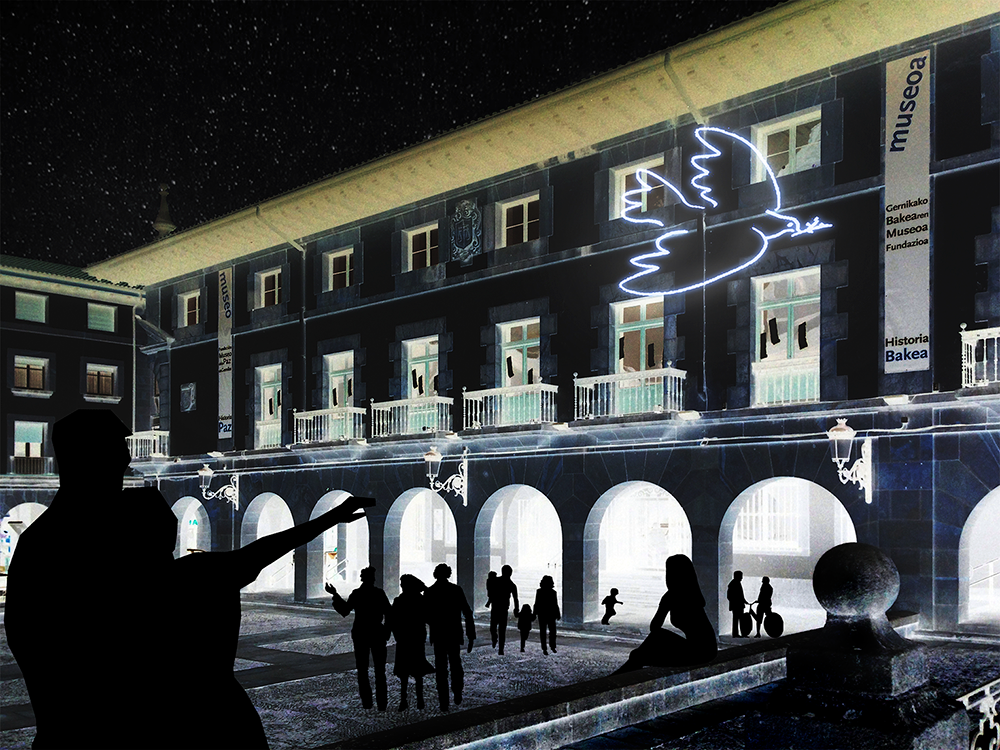The tender to remodel the Gernika Peace Museum was born out of a strong desire to adapt its discourse to the situation today, establishing a way of understanding the socio-political museum as a kind of living organism. Our proposal addressed the conceptual transformation of the museum rather than the formal and economic remodel. The opportunity of this rehabilitation was twofold: to update its contents and renew what contains them.
 Innovative, creative and genuine museum curation was proposed, not so much through the exhibition devices used as the proposed paradigm shift for the museum. The museum would stop telling a story and turn visitors into researchers, acting at the scriptwriters and absolute stars of the story itself, emphasising their individuality and opening the space to all sensibilities. The Gernika Peace Museum covers the very recent past, yet to be written, which, in being saved and classified, would become a metaphor for the irreversible.
Innovative, creative and genuine museum curation was proposed, not so much through the exhibition devices used as the proposed paradigm shift for the museum. The museum would stop telling a story and turn visitors into researchers, acting at the scriptwriters and absolute stars of the story itself, emphasising their individuality and opening the space to all sensibilities. The Gernika Peace Museum covers the very recent past, yet to be written, which, in being saved and classified, would become a metaphor for the irreversible.
 The very idea that the museum could contain a Memory Chest transformed its content into a legacy. Not only did it reproduce texts and images, it also contained and classified them by reflecting the end of one period and the beginning of another, building the image of a collective triumph and promoting a new consciousness, for all to see.
The very idea that the museum could contain a Memory Chest transformed its content into a legacy. Not only did it reproduce texts and images, it also contained and classified them by reflecting the end of one period and the beginning of another, building the image of a collective triumph and promoting a new consciousness, for all to see.
 The proposal developed the spaces in the stairwell and on the second floor, but also offered the possibility of implementing subtle actions on the first floor, reversing the direction of the tour. Schematically, the change can be summed up as having created an introductory area, dividing the areas into “Introduction”, “Bombardment” and “Answers”, and culminating the “Answers” area with a Human Rights section, located in the stairwell.
The proposal developed the spaces in the stairwell and on the second floor, but also offered the possibility of implementing subtle actions on the first floor, reversing the direction of the tour. Schematically, the change can be summed up as having created an introductory area, dividing the areas into “Introduction”, “Bombardment” and “Answers”, and culminating the “Answers” area with a Human Rights section, located in the stairwell.

This sequence was complemented with two refurbishment actions of the second floor: on the one hand, the final scope was a nod to the introduction area, linking the beginning and the end of the visit under the local-global heading; and, on the other hand, we proposed having visitors take the emergency stairs down, without crossing or repeating the itinerary. Along these lines of linking the new curation with the existing one, the Memory Chest was based on the paths of peace: the space as a metaphor.

The museum as an actor
The Gernika Peace Museum had to visibly reflect a change in the situation. Refurbishing the stairwell and the second floor was not only an opportunity to adapt the contents to reflect the new socio-political feelings of hope, but also to give the museum itself a new meaning as a player in the process. A place of consensus and participation, open to as many readings as people who visit, that might spark an experience that could not be replaced, although it could be completed, by other forms of communication. A place where visitors would be called upon to act as a catalyst for awareness and emotions.

The people as a conclusion
The proposed remodel of the Gernika Peace Museum turned the museum curation into a new setting where everyone could look, read, listen and speak in freedom. A place where the visitor-actor would build up their own narrative; a space that would appeal to a total transformation of the narrative meaning. A space where our recent history and the future to come would no longer be a series of chapters, of rooms one after another, but would materialise the new situation in a unique space, a landscape where visitors could wander in complete freedom, where the construction of their perception depends on them, too. A single place where the past, present and future would coexist, and where there would be no interaction or meaning without the visitor.



